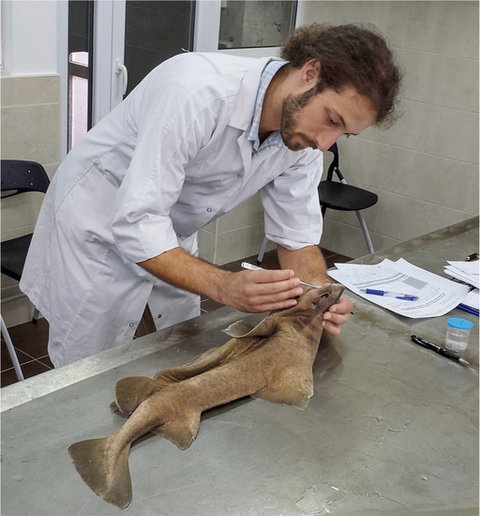SharkSightings
Indeeperwater,Gajićhascomeuponroughsharksandlanternsharks.Hedoesn’tneedhiscameralighttoseelanternsharks.Theyglow!Thelightcomesfrommanysmallorgansthatdottheirbelliesand sides.
It'seasierforGajićtoworkwithraysandskatesthanwithsharks.Hecangetclosertorays,suchasstingrays,ashestudies them.
ForGajić,thisisadreamcometrue.HegrewupinthecountryofYugoslavia.Heneverlivedneartheocean.Yet,hewasfascinatedbytheseaandwhatlivedinit.Hevowedtoonedayswimwith sharks.

researchingunbornsmoothhound sharks

Gajićexaminesadeep-waterroughsharkinthe lab.
DangerousWaters
GajićknowsthatsharksareintroubleintheAdriatic.Pollutioniscausingillnesses.Plastics,pesticides,andwastepoisonthe sea.Sewage,forexample,flowsintothesea.Thisbecomes hazardous.
Outwardly,amarineanimalmightseemhealthy.Toknowforcertain,however,Gajićmustputonhislabcoat.Hemustexaminesharkorgansand tissue.
UndertheMicroscope
Mosttissuesamplesaretakenfromalready-deadsharks.Thesecomeintheformofbycatch.That’swhenasharkisaccidentallycaughtinafisher’snetandkilled.Whenthishappens,localfisherscall Gajić.
Inthelab,eachsharkisgivenafullx-rayandascan.Tissuesamplesarethentaken.Fromthesesamples,Gajićcanlearnalot.Inoneshark,hefoundthediseasehepatitis.That’sadiseaseoftheliver.Itmightbecausedbymetalpollutioninthewater.Inothersharks,hefounddiseaseintheirkidneysand brains.

ThissevengillsharkwasbycatchoffthecoastofMalta.ThisisintheMediterranean Sea.